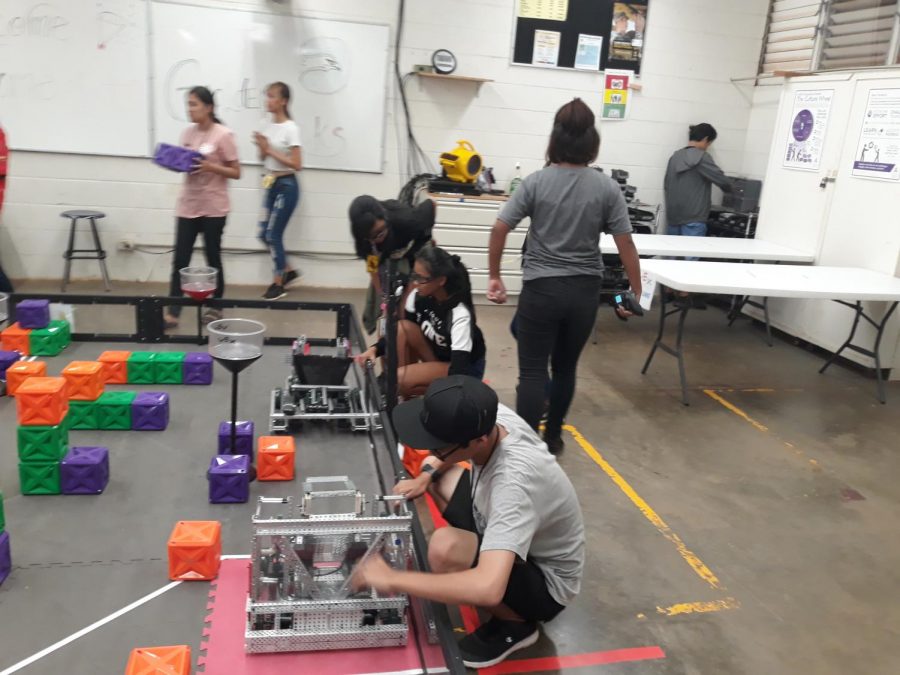NHIS Academies in the Works for 2020-2021 School Year
Beginning in the 2020-2021 school year, Nānākuli High and Intermediate School will transition into an academy structure school. An academy structure is based around a Career Technical Education (CTE) area or theme. Right now, NHIS has five CTE pathways, but they are electives and not academy structured. The school will have two academies: a Design Academy and a Sustainability Academy, with each having four career pathways.
“Academies will have teachers assigned to each academy and the teachers will work together and the curriculum will be integrated. Thus a student could be working on a project that involves writing, math computation, and the CTE/pathway skills all put together. Right now, everything is standalone and there is no connection with CTE with core content,” said Robotics teacher Richard Enright.
The Design Academy will include the following pathways: Coding, Marine Mechanics, Building and Construction and Fashion Design. The Sustainability Academy will include the following pathways: Natural Resources, Public/Clinical Health, Business-Entrepreneurial/Virtual-Entrepreneurial, and Education.
The academies and pathways were selected collaboratively by the administration and a leadership group composed of teachers and students.
One of the main reasons for NHIS moving to the academy structure is to better prepare students for life after high school. According to Darin Pilialoha NHIS Principal, he wants to see that the school offers more than just earning credits to get a diploma.
“We want to set up career pathway structures that a student is interested in and has a connection to early college or certification programs,” said Pilialoha.
Jessica Matsik NHIS CSI Coordinator added, “So the high school student has more of a personalized experience, has more of a direct line to possible career or college. We don’t want to continue to, you know, work really hard and have these kids just going through the motions and stay in high school to get your credit and then you go on and move on. We want to make sure that the high school experience is more appealing and that we have fewer kids chronically absent. We have more kids engaged in class.”
Students have expressed some excitement and concern to the news that NHIS will be transitioning to an academy school structure.
“I feel that its gonna be a great opportunity personally. I’m kinda excited, but I’m concerned that if I choose the pathway I think is interesting but it turns out to not be something I don’t want to do, getting out of it is gonna be annoying. Also concerned that some students or friends are gonna think of this as more work for them to do,” said Eighth Grader Leinee Marie Loa.
“My biggest concern about the school moving to academies next year is about the students who are not interested in any of the academies provided. What if they wanted to do something else? Will the students be forced to be in an academy that they do want to be in?” said Junior Emma Seeya. “I know the academies are supposed to benefit students who want to enter that certain career field in the future but what would happen if they had different goals? If the kids are not interested in what they are learning, then they won’t care to pass.”
In order to address these concerns, Pilialoha feels that communication is key — working with students to make connections from their passions into different careers.
“(By) educating students and making connections to what we have. For example, if a student is interested in becoming a professional athlete what would happen after they are done with their careers? Having those conversations with students in what will they fall back on,” said Pilialoha.
Not only will the academies affect the students, but it will also cause change for many teachers. Core teachers in high school will be teaching two different grade levels of a core content class. Currently, in high school, core teachers only teach one grade level. Another big impact that the academies will have on teachers is that they have to teach performance-based lessons — these types of lessons require students to problem solve and use the skills they learned in class to create a final product, to demonstrate learning.
“From the teachers’ perspective, it’s going to take more time to develop lessons. There will be more work for teachers but the stuff you will be doing in class is what you will be doing in the real world,” said Enright.
“One example of a performance-based lesson would be for students in the Natural Resource pathway would be to investigate an environmental issue in the Nānākuli or Waianae community. The skills they learned in English will be used to write their proposals. The skills they learn in science would be used to teach them how to conduct an experiment. They would use the content they learned in social studies to understand the historical perspective. Lastly, they would use math to apply data analysis,” said Student Activities Coordinator Robin Kitsu.
Kitsu added, “This final project would be presented to the respective community or state officials with recommendations on how to address the problem. This is very different from a student writing a research paper and giving it to a teacher and nothing happens. Also, it is different because the work done in English, social studies, math, and science would all relate to this one project.”
The overall hope for NHIS by doing these academies is to set students up to be career-ready and to help them have a plan for the future. Other things they hope to improve is classroom engagement and student attendance.
“One of the scariest feelings is to be sitting out on the football field on graduation day, earning a diploma, but not knowing what you’re going to do for the rest of your life. By moving to the academy concept, we hope to eliminate that fear,” said Kitsu.


